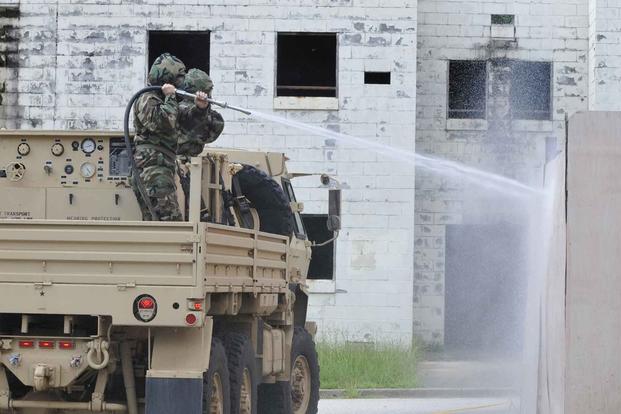This story, part of a series of investigative reporting projects by Military.com on veterans health, was supported by the Pulitzer Center.
Julie Akey was just 46 when she was diagnosed with multiple myeloma, a blood cancer that she describes as an "old man's disease," typically diagnosed in those 65 and older.
The news shocked the former Army linguist. She had no family history of the relatively uncommon disease.
While searching for a potential cause, Akey learned that a location where she once lived, Fort Ord, California, was designated a Superfund site in 1991 by the Environmental Protection Agency for extensive contamination of its soil and groundwater. Even today, parts of the former installation are so polluted, they can't be redeveloped.
Read Next: Second Fort Jackson Drill Sergeant Found Dead on Base This Month
"I'm not a scientist, but in my opinion, it was the [solvent trichloroethylene]," Akey said, citing an industrial chemical used extensively by the Army that contaminates an aquifer beneath Fort Ord as the cause of her disease. "To this day, there is still a TCE plume in the water there."
The problem is not unique to Fort Ord. Across the country and around the world, environmental pollution at active and former U.S. military sites has created the specter of potential health threats for former service members and their families who worked and lived in places now known to have been contaminated.
The list of exposures and illnesses among former military personnel seems endless: firefighters with testicular cancer linked to the foam used by the Defense Department; military aviation crews with higher rates of brain and nervous system cancers than is normal; missileers with non-Hodgkin lymphoma; female troops with a 40% higher chance of developing breast cancer than their civilian counterparts; and post-9/11 veterans with twice the diagnosis rate of amyotrophic lateral sclerosis, or ALS, than the general population.
The 2022 Sergeant First Class Heath Robinson Honoring Our Promise to Address Comprehensive Toxics, or PACT, Act provided a pathway for millions of ill veterans to obtain health care and disability compensation for environmental exposures abroad, one of the largest expansions of Department of Veterans Affairs benefits in the history of the agency.
But many veterans and their families who lived through potential exposures closer to home in the U.S. -- like Fort Ord -- were not included and face an arduous process proving their illnesses are tied to military life, often with minimal assistance or guidance from the VA.
Akey, who has amassed research linking TCE exposure to multiple myeloma and other blood cancers, has been denied twice for her condition.
"This summer, I filed again and it hasn't been denied, but it's come back and they have asked me for so many different things. I feel like they are just stringing me along. It's 'wait, deny and then they die.' I really feel like that," Akey said.
The VA has always had something of a two-tiered system for handling help for those facing health consequences from their lives in and around the military. Some conditions are automatically accepted as tied to service, known as presumptive conditions, allowing for a streamlined course for receiving benefits.
The PACT Act opened this path for veterans sickened by burn pits and other environmental pollutants in the Middle East, Afghanistan and elsewhere, making more than 20 disease classifications eligible for expedited health care and benefits.
But those who suspect their illnesses were caused by contamination at U.S. installations elsewhere aren't covered by the law, leaving them to prove via extensive paperwork that their illnesses are "service connected" -- a monumental task, they say, especially for ailments like cancer that are slow to develop, leaving years between exposure and consequences.
Roughly 2,300 miles away from Fort Ord lies another closed Army post, Fort McClellan, Alabama, once home to the service's Chemical Corps School, the Army Development Command Chemical/Biological/Radiological Agency, the Army Military Police School and more.
While the base is not a designated Superfund site, the former installation was possibly contaminated with radioactive compounds and chemical warfare agents, according to the VA.
Another potential source of toxic exposure for those assigned to or who trained at Fort McClellan was a Monsanto plant in nearby Anniston that was forced to pay the residents of the town a $700 million settlement in 2003 for allegedly dispersing polychlorinated biphenyls, or PCBs, for decades in the region. The chemicals are linked to birth defects, weakened immune systems and certain types of cancer.

Service members assigned to Fort McClellan were not part of that settlement.
"I can only say with a degree of certainty that there are thousands and thousands of Fort McClellan veterans suffering from a wide variety of rare and not so rare cancers and adverse health conditions that would otherwise be presumptive if they served in Vietnam or Camp Lejeune [North Carolina]," said Bill Bonk, a former Army officer who trained at the base in the early 1980s and wrote a book about contamination on the installation.
Halfway across the world, also in the 1980s, Betty Seaman and her husband, Navy Capt. Jim Seaman, lived at Naval Air Facility Atsugi, Japan, where they thought nothing of a neighboring commercial incinerator that frequently belched black smoke across the base.
In his later years, Seaman, an A-6 Intruder pilot, was an avid cyclist who liked to paddleboard and kayak, and he built his dream retirement home in Hollywood, Maryland, near Naval Air Station Patuxent River. But three months after moving into the house, Seaman was diagnosed with lung cancer. He died five months later at age 61.
Seaman was never a smoker. His widow Betty thinks Atsugi may be to blame.
"We just assumed if [the incinerator] was something horrible, they would have told us," said Betty, who has become an advocate for families of pilots and those assigned to Atsugi who have developed cancer. "Three out of four of us have had cancer in my family."
'Wait, Deny and Then They Die'
It is difficult to directly connect an environmental exposure to a person's medical condition even if research shows a cause and effect because there may be no paperwork on the extent or specific type of an individual's exposure.
Research by various arms of the federal government, including the VA, the Army and the Navy, has said that no one at Fort Ord consumed unsafe water, that there is no increased cancer risk among residents at Atsugi or high levels of toxic exposure at Fort McClellan.
It can take decades for illnesses tied to exposure to surface, and often decades further for the VA to establish any presumptive conditions for an exposure. Herbicides used in Vietnam, which didn't see applicable legislation until 1991, contaminated water consumed by residents of Camp Lejeune for 30 years before finally being formally recognized in 2017. Burn pits were acknowledged as a cause of illness by the PACT Act 16 years after an Air Force colonel warned of their potential to cause chronic health conditions.
In the interim periods, the federal government often denied any connection between a contaminant and an illness, contracted studies to disprove a connection, prevented the disclosure of documents on known environmental hazards, or ignored expert advice on potential consequences.
It happened with Vietnam veterans and Agent Orange, with Persian Gulf War veterans cleaning a water treatment facility or destroying a chemical storage facility, with service members and families at Camp Lejeune, and with troops and contractors living and working alongside burn pits.
It's understandable, said Shane Liermann, a former Marine who serves as national deputy legislative director for Disabled American Veterans, that affected veterans are angry.
"[The federal government] missed the opportunity in many instances to do the right thing," Liermann said. "We can't just ignore each of these [exposures] or all of these for another 30 years. Too many veterans are not going to have access to what they need to survive."
The VA has the ability to establish presumptive conditions without congressional input or studies from outside sources.
Even before passage of the PACT Act, the VA designated three conditions -- rhinitis, sinusitis and asthma -- as well as nine rare respiratory cancers as linked to service in the Persian Gulf region and elsewhere.
Liermann said he would like to see the VA use that authority to broaden the list of presumptive conditions or find a way to "upfront, make it easier to get service connection for a condition before it becomes a presumptive."
"I know everyone likes to say the phrase 'veteran-centric,' but this really needs to be 'life-centric.' The longer we wait, veterans are having more health problems and losing their quality of life. They may be losing family members. We need to take quicker action," Liermann said.
At nearly every opportunity he gets, VA Secretary Denis McDonough tells former service members they should file claims for any injury or illness they believe is service-connected even if it is not an established presumptive condition.
"Veterans who did not serve in Central Command [in the Middle East] but who have been exposed to toxins, we urge them to file a claim, and then we'll work through with them establishing a service connection," McDonough said during a press conference in July.

Without the presumptive connection to service for a medical condition, however, the pathway to receiving VA disability is an enormous challenge.
VA Press Secretary Terrence Hayes said the department does not track specific military exposures other than what is covered under the PACT Act, nor does it have "site-specific data that we can link to claimed conditions."
"VA continues to further explore and study the effects of all toxic exposures concerning veterans and follow the science when it comes to treating these conditions and granting service connection for disabilities as appropriate," Hayes wrote in a statement to Military.com. "While these studies are ongoing, service-connected disabilities are not a requirement to receive care at VA, and we encourage all eligible veterans to sign up for care at VA."
Akey maintains a spreadsheet of nearly 1,300 former residents of Fort Ord who are sick, including 149 with multiple myeloma and hundreds of others with blood cancers. She has a six-page letter from her doctor testifying that her illness was caused by exposure to TCE.
Yet her VA claim has been denied and she is aware of just one veteran whose colon cancer claim citing per- and polyfluoroalkyl chemicals, or PFAS, contamination at Fort Ord was approved.
Bonk said that some veterans have had their claims approved and posted their elation on Fort McClellan social media groups that he belongs to, with success rates seemingly ticking up following the passage of the PACT Act, but "there are still scores denied."
Betty Seaman, who is in contact with pilots affected by cancer and family members who lived at Atsugi, said the path to claims is "very restrictive" regarding locations under the PACT Act.
"Every person I have ever dealt with [at the VA] has been committed and sincere in wanting to help," she said. "But when you've just been hit with a cancer diagnosis, can't get the VA to acknowledge it and get treatment, you don't see that."
The PACT Act Spotlight
The military services, Defense Department and VA are conducting or planning to launch studies on potential exposures at various locations where veterans have already reported problems.
The Air Force is working to determine whether 14 types of cancer are more common in active-duty personnel and veterans who worked on nuclear missile bases after a former missileer raised concerns over possible cancer clusters in December 2022.
The VA was required, under the PACT Act, to conduct an epidemiological study of Fort McClellan and has hired a contractor, Prometheus Federal Services, to conduct the research, with the study design expected to be released in late 2024.
The Department of Defense launched an investigation in 2017 to determine the extent of PFAS contamination at 714 military installations. To date, it has found that 359 former and active military sites will require cleanup, while another 248 are still in the testing phase. The remaining 107 don't require further remediation work, according to the department.
PFAS chemicals have been used by the DoD for decades in firefighting foam used for training and response to aviation mishaps and shipboard fires. The man-made substances, dubbed "forever chemicals" because they don't break down in the environment, have been tied to testicular and kidney cancer, as well as low sperm counts, preeclampsia in pregnant women and diminished vaccine response in children.
The VA has a research study in the works that will investigate PFAS levels in military firefighters and construction workers and look at any correlations between those levels and cardiometabolic diseases such as heart attack, stroke and insulin resistance.
The results of that study are expected in 2026, according to McDonough.
The DoD was also ordered by Congress to test military firefighters' PFAS levels.
Each of these efforts is welcomed by veterans and veterans service organizations, said Liermann, who penned a white paper for the DAV on Fort McClellan urging Congress to establish a concession of exposure for all veterans who served there. But the results can't come fast enough for affected veterans, he added.
"The PACT Act has raised a level of awareness that we've never seen before, which is great because veterans who are getting diseases associated with these exposures, even domestically, we can't just ignore ... for another 30 years," Liermann said.
The VA is in the process of considering adding several types of blood cancers to the list of presumptives under the PACT Act, including multiple myeloma that originates below the neck.
But it won't help people like Akey, who never deployed to an area listed in the legislation.
"They're just stringing me along, just waiting till I'm just too sick or too tired, too fed up to keep going with this darn VA claim," she said. "I think it's because if they approve mine -- and this is why I'm fighting so hard -- then I will set a precedent for other people, for all these other people who are sick and have been denied as well."
Related: VA Plans Outreach to Screen 3 Million More Veterans for Toxic Exposures








